Application Potential of Constructed Wetlands on Different Operation Mode for Biologically Pre-Treatment of Rural Domestic Wastewater
Abstract
1. Introduction
2. Materials and Methods
2.1. Schematic of the Experimental Devices
2.2. Sewage Characterization and Experimental Setup
2.3. Analytical Methods
2.4. Microbial Community Analysis
2.5. Data Analysis
3. Results and Discussion
3.1. Performance of Pollutant Removal during the Long-Term Operation
3.2. Microbial Community Structure and Bacterial Diversity in the TFCW and HFCW
3.3. Performance for Pollutant Removal at Low Temperatures
4. Conclusions
Supplementary Materials
Author Contributions
Funding
Institutional Review Board Statement
Informed Consent Statement
Data Availability Statement
Conflicts of Interest
References
- Li, J.; Lu, X. Performance and Microbial Diversity in a Low-Energy ANF-WDSRBC System for the Post-Treatment of Decentralized Domestic Wastewater. Water 2017, 9, 330. [Google Scholar] [CrossRef]
- Ma, Y.; Zhai, Y.; Zheng, X.; He, S.; Zhao, M. Rural domestic wastewater treatment in constructed ditch wetlands: Effects of influent flow ratio distribution. J. Clean. Prod. 2019, 225, 350–358. [Google Scholar] [CrossRef]
- Chen, F.; Yao, Q. The Development of Rural Domestic Wastewater Treatment in China. Adv. Mat. Res. 2015, 1073–1076, 829–832. [Google Scholar] [CrossRef]
- Wang, L.; Zheng, Z.; Luo, X.; Zhang, J. Performance and mechanisms of a microbial-earthworm ecofilter for removing organic matter and nitrogen from synthetic domestic wastewater. J. Hazard Mater. 2011, 195, 245–253. [Google Scholar] [CrossRef]
- Han, Y.; Ma, J.; Xiao, B.; Huo, X.; Guo, X. New Integrated Self-Refluxing Rotating Biological Contactor for rural sewage treatment. J. Clean. Prod. 2019, 217, 324–334. [Google Scholar] [CrossRef]
- Li, D.; Wang, X.; Chi, L.; Wang, J. The design and operation of subsurface wastewater infiltration systems for domestic wastewater. Water Environ. Res. 2019, 91, 843–854. [Google Scholar] [CrossRef]
- Hong, Y.; Huang, G.; An, C.; Song, P.; Xin, X.; Chen, X.; Zhang, P.; Zhao, Y.; Zheng, R. Enhanced nitrogen removal in the treatment of rural domestic sewage using vertical-flow multi-soil-layering systems: Experimental and modeling insights. J. Environ. Manag. 2019, 240, 273–284. [Google Scholar] [CrossRef] [PubMed]
- Singh, R.P.; Kun, W.; Fu, D. Designing process and operational effect of modified septic tank for the pre-treatment of rural domestic sewage. J. Environ. Manage. 2019, 251, 109552. [Google Scholar] [CrossRef]
- Kalbar, P.P.; Karmakar, S.; Asolekar, S.R. Selection of an appropriate wastewater treatment technology: A scenario-based multiple-attribute decision-making approach. J. Environ. Manag. 2012, 113, 158–169. [Google Scholar] [CrossRef]
- Ren, X.; Shon, H.K.; Jang, N.; Lee, Y.G.; Bae, M.; Lee, J.; Cho, K.; Kim, I.S. Novel membrane bioreactor (MBR) coupled with a nonwoven fabric filter for household wastewater treatment. Water Res. 2010, 44, 751–760. [Google Scholar] [CrossRef]
- Li, P.; Zheng, T.; Li, L.; Ma, Y.; Sun, X.; Liu, J. An appropriate technique for treating rural wastewater by a flow step feed system driven by wind-solar hybrid power. Environ. Res. 2020, 187, 109651. [Google Scholar] [CrossRef] [PubMed]
- Wang, T. Study on rural domestic sewage treatment scheme. IOP. Conf. Ser.: Earth Environ. Sci. 2021, 781, 32040. [Google Scholar] [CrossRef]
- Ge, S.; Peng, Y.; Qiu, S.; Zhu, A.; Ren, N. Complete nitrogen removal from municipal wastewater via partial nitrification by appropriately alternating anoxic/aerobic conditions in a continuous plug-flow step feed process. Water Res. 2014, 55, 95–105. [Google Scholar] [CrossRef] [PubMed]
- Zha, X.; Ma, J.; Lu, X. Performance of a coupling device combined energy-efficient rotating biological contactors with anoxic filter for low-strength rural wastewater treatment. J. Clean. Prod. 2018, 196, 1106–1115. [Google Scholar] [CrossRef]
- Cheng, F.; Wang, C.; Wen, C.; Wang, S.; Cheng, H.; Shen, S.; Lu, X. Full-scale application and performance of a low-consuming system for decentralized village domestic wastewater treatment. J. Water. Process. Eng. 2022, 46, 102594. [Google Scholar] [CrossRef]
- Zekker, I.; Raudkivi, M.; Artemchuk, O.; Rikmann, E.; Priks, H.; Jaagura, M.; Tenno, T. Mainstream-sidestream wastewater switching promotes anammox nitrogen removal rate in organic-rich, low-temperature streams. Environ. Technol. 2021, 42, 3073–3082. [Google Scholar] [CrossRef]
- Huang, Z.; Qie, Y.; Wang, Z.; Zhang, Y.; Zhou, W. Application of deep-sea psychrotolerant bacteria in wastewater treatment by aerobic dynamic membrane bioreactors at low temperature. J. Membrane. Sci. 2015, 475, 47–56. [Google Scholar] [CrossRef]
- Zhou, H.; Li, X.; Xu, G.; Yu, H. Overview of strategies for enhanced treatment of municipal/domestic wastewater at low temperature. Sci. Total. Environ. 2018, 643, 225–237. [Google Scholar] [CrossRef]
- Zheng, H.; Jiang, L.; Cao, X.; Liao, Y.; Mao, Y.; Ji, F. A combined deodorization reflux system and tidal flow constructed wetland for sewage treatment performance. J. Environ. Chem. Eng. 2022, 10, 106953. [Google Scholar] [CrossRef]
- Li, C.; Wu, S.; Dong, R. Dynamics of organic matter, nitrogen and phosphorus removal and their interactions in a tidal operated constructed wetland. J. Environ. Manag. 2015, 151, 310–316. [Google Scholar] [CrossRef]
- Lin, Y.-F.; Jing, S.-R.; Wang, T.-W.; Lee, D.-Y. Effects of macrophytes and external carbon sources on nitrate removal from groundwater in constructed wetlands. Environ. Pollut. 2002, 119, 413–420. [Google Scholar] [CrossRef] [PubMed]
- Jia, W.; Zhang, J.; Wu, J.; Xie, H.; Zhang, B. Effect of intermittent operation on contaminant removal and plant growth in vertical flow constructed wetlands: A microcosm experiment. Desalination 2010, 262, 202–208. [Google Scholar] [CrossRef]
- Austin, D. Influence of cation exchange capacity (CEC) in a tidal flow, flood and drain wastewater treatment wetland. Ecol. Eng. 2006, 28, 35–43. [Google Scholar] [CrossRef]
- Chang, Y.; Wu, S.; Zhang, T.; Mazur, R.; Pang, C.; Dong, R. Dynamics of nitrogen transformation depending on different operational strategies in laboratory-scale tidal flow constructed wetlands. Sci. Total. Environ. 2014, 487, 49–56. [Google Scholar] [CrossRef] [PubMed]
- Ju, X.; Wu, S.; Huang, X.; Zhang, Y.; Dong, R. How the novel integration of electrolysis in tidal flow constructed wetlands intensifies nutrient removal and odor control. Bioresour. Technol. 2014, 169, 605–613. [Google Scholar] [CrossRef]
- Wu, S.; Zhang, D.; Austin, D.; Dong, R.; Pang, C. Evaluation of a lab-scale tidal flow constructed wetland performance: Oxygen transfer capacity, organic matter and ammonium removal. Ecol. Eng. 2011, 37, 1789–1795. [Google Scholar] [CrossRef]
- Vymazal, J.; Kröpfelová, L. Multistage hybrid constructed wetland for enhanced removal of nitrogen. Ecol. Eng. 2015, 84, 202–208. [Google Scholar] [CrossRef]
- Kato, K.; Inoue, T.; Ietsugu, H.; Koba, T.; Sasaki, H.; Miyaji, N.; Kitagawa, K.; Sharma, P.K.; Nagasawa, T. Performance of six multi-stage hybrid wetland systems for treating high-content wastewater in the cold climate of Hokkaido, Japan. Ecol. Eng. 2013, 51, 256–263. [Google Scholar] [CrossRef]
- Ji, B.; Zhao, Y.; Vymazal, J.; Qiao, S.; Wei, T.; Li, J.; Mander, Ü. Can subsurface flow constructed wetlands be applied in cold climate regions? A review of the current knowledge. Ecol. Eng. 2020, 157, 105992. [Google Scholar] [CrossRef]
- APHA. Standard Methods for the Examination of Water and Wastewater; National Government Publication: Washington, DC, USA, 2005. [Google Scholar]
- Zha, X.; Ma, J.; Tsapekos, P.; Lu, X. Evaluation of an anaerobic baffled reactor for pretreating black water: Potential application in rural China. J. Environ. Manage. 2019, 251, 109599. [Google Scholar] [CrossRef]
- Zha, X.; Ma, J.; Lu, X. Use of a low-cost and energy-efficient device for treating low-strength wastewater at low temperatures focusing on nitrogen removal and microbial community. Sci. Total. Environ. 2020, 722, 137916. [Google Scholar] [CrossRef]
- Liu, X.; Wang, Y.; Lu, S.; Liu, Y.; Zhao, B.; Xi, B.; Guo, X.; Guo, W.; Zhang, J. Intensified sulfamethoxazole removal in an electrolysis-integrated tidal flow constructed wetland system. Chem. Eng. J. 2020, 390, 124545. [Google Scholar] [CrossRef]
- Li, M.; Du, C.; Liu, J.; Quan, X.; Lan, M.; Li, B. Mathematical modeling on the nitrogen removal inside the membrane-aerated biofilm dominated by ammonia-oxidizing archaea (AOA): Effects of temperature, aeration pressure and COD/N ratio. Chem. Eng. J. 2018, 338, 680–687. [Google Scholar] [CrossRef]
- Liu, H.; Hu, Z.; Zhang, J.; Ngo, H.H.; Guo, W.; Liang, S.; Fan, J.; Lu, S.; Wu, H. Optimizations on supply and distribution of dissolved oxygen in constructed wetlands: A review. Bioresour. Technol. 2016, 214, 797–805. [Google Scholar] [CrossRef] [PubMed]
- Mburu, N.; Rousseau, D.P.; van Bruggen, J.J.; Thumbi, G.; Llorens, E.; Garcia, J.; Lens, P.N. Reactive transport simulation in a tropical horizontal subsurface flow constructed wetland treating domestic wastewater. Sci. Total. Environ. 2013, 449, 309–319. [Google Scholar] [CrossRef]
- Hu, Y.; Zhao, Y.; Rymszewicz, A. Robust biological nitrogen removal by creating multiple tides in a single bed tidal flow constructed wetland. Sci. Total. Environ. 2014, 470–471, 1197–1204. [Google Scholar] [CrossRef] [PubMed]
- Ilyas, H.; Masih, I. The performance of the intensified constructed wetlands for organic matter and nitrogen removal: A review. J. Environ. Manag. 2017, 198, 372–383. [Google Scholar] [CrossRef]
- Metcalf, L.; Eddy, H.P.; Tchobanoglous, G. Wastewater Engineering: Treatment, Disposal, and Reuse; McGrawHill: New York, NY, USA, 1991; Volume 4. [Google Scholar]
- Hu, Y.; Zhao, Y.; Zhao, X.; Kumar, J.L.G. High Rate Nitrogen Removal in an Alum Sludge-Based Intermittent Aeration Constructed Wetland. Environ. Sci. Technol. 2012, 46, 4583–4590. [Google Scholar] [CrossRef]
- Chang, J.; Mei, J.; Jia, W.; Chen, J.; Li, X.; Ji, B.; Wu, H. Treatment of heavily polluted river water by tidal-operated biofilters with organic/inorganic media: Evaluation of performance and bacterial community. Bioresour. Technol. 2019, 279, 34–42. [Google Scholar] [CrossRef]
- Ni, Q.; Wang, T.; Liao, J.; Shi, W.; Huang, Z.; Miao, H.; Wu, P.; Ruan, W. Operational Performances and Enzymatic Activities for Eutrophic Water Treatment by Vertical-Flow and Horizontal-Flow Constructed Wetlands. Water 2020, 12, 2007. [Google Scholar] [CrossRef]
- Chand, N.; Kumar, K.; Suthar, S. Enhanced wastewater nutrients removal in vertical subsurface flow constructed wetland: Effect of biochar addition and tidal flow operation. Chemosphere 2021, 286, 131742. [Google Scholar] [CrossRef] [PubMed]
- Wang, R.; Zhao, X.; Liu, H.; Wu, H. Elucidating the impact of influent pollutant loadings on pollutants removal in agricultural waste-based constructed wetlands treating low C/N wastewater. Bioresour. Technol. 2019, 273, 529–537. [Google Scholar] [CrossRef] [PubMed]
- Bolton, L.; Joseph, S.; Greenway, M.; Donne, S.; Munroe, P.; Marjo, C.E. Phosphorus adsorption onto an enriched biochar substrate in constructed wetlands treating wastewater. Ecol. Eng. 2019, 142, 100005. [Google Scholar] [CrossRef]
- Yakar, A.; Türe, C.; Türker, O.C.; Vymazal, J.; Saz, Ç. Impacts of various filtration media on wastewater treatment and bioelectric production in up-flow constructed wetland combined with microbial fuel cell (UCW-MFC). Ecol. Eng. 2018, 117, 120–132. [Google Scholar] [CrossRef]
- Zhang, J.; Wang, Q.; Fan, J.; Xie, H.; Liu, C.; Liang, S.; Hu, Z.; Yang, Z.; Zhao, C. Comparisons of microbial abundance and community among different plant species in constructed wetlands in summer. Ecol. Eng. 2015, 82, 376–380. [Google Scholar] [CrossRef]
- Liu, T.; Xu, S.; Lu, S.; Qin, P.; Bi, B.; Ding, H.; Liu, Y.; Guo, X.; Liu, X. A review on removal of organophosphorus pesticides in constructed wetland: Performance, mechanism and influencing factors. Sci. Total. Environ. 2019, 651, 2247–2268. [Google Scholar] [CrossRef]
- Chen, D.; Gu, X.; Zhu, W.; He, S.; Wu, F.; Huang, J.; Zhou, W. Denitrification- and anammox-dominant simultaneous nitrification, anammox and denitrification (SNAD) process in subsurface flow constructed wetlands. Bioresour. Technol. 2019, 271, 298–305. [Google Scholar] [CrossRef]
- Ansola, G.; Arroyo, P.; Saenz de Miera, L.E. Characterisation of the soil bacterial community structure and composition of natural and constructed wetlands. Sci. Total. Environ. 2014, 473–474, 63–71. [Google Scholar] [CrossRef]
- Yan, Q.; Min, J.; Yu, Y.; Zhu, Z.; Feng, G. Microbial community response during the treatment of pharmaceutically active compounds (PhACs) in constructed wetland mesocosms. Chemosphere 2017, 186, 823–831. [Google Scholar] [CrossRef]
- Ren, M.; Zhang, Z.; Wang, X.; Zhou, Z.; Chen, D.; Zeng, H.; Zhao, S.; Chen, L.; Hu, Y.; Zhang, C.; et al. Diversity and Contributions to Nitrogen Cycling and Carbon Fixation of Soil Salinity Shaped Microbial Communities in Tarim Basin. Front. Microbiol. 2018, 9, 431. [Google Scholar] [CrossRef]
- Zhao, Y.; Song, X.; Cao, X.; Wang, Y.; Zhao, Z.; Si, Z.; Yuan, S. Modified solid carbon sources with nitrate adsorption capability combined with nZVI improve the denitrification performance of constructed wetlands. Bioresour. Technol. 2019, 294, 122189. [Google Scholar] [CrossRef] [PubMed]
- Chen, P.; Wu, J.; Lu, X.; Yu, R. Denitrifying phosphorus removal and microbial community characteristics of two-sludge DEPHANOX system: Effects of COD/TP ratio. Biochem. Eng. J. 2021, 172, 108059. [Google Scholar] [CrossRef]
- Wen, Z.D.; Gao, D.W.; Wu, W.M. Biodegradation and kinetic analysis of phthalates by an Arthrobacter strain isolated from constructed wetland soil. Appl. Microbiol. Biotechnol. 2014, 98, 4683–4690. [Google Scholar] [CrossRef]
- Fredrickson, J.K.; Balkwill, D.L.; Romine, M.F.; Shi, T. Ecology, physiology, and phylogeny of deep subsurface Sphingomonas sp. J. Ind. Microbiol. Biot. 1999, 23, 273–283. [Google Scholar] [CrossRef]
- Wang, X.j.; Wang, W.q.; Zhang, J.; Wang, S.; Li, J. Dominance of Candidatus saccharibacteriain SBRs achieving partial denitrification: Effects of sludge acclimating methods on microbial communities and nitrite accumulation. RSC Adv. 2019, 9, 11263–11271. [Google Scholar] [CrossRef]
- Tang, P.; Xiang, Z.; Zhou, Y.; Zhang, Y. Enzyme treatment improves the performance of laboratory-scale vertical flow constructed wetland. Bioresour. Technol. 2018, 268, 665–671. [Google Scholar] [CrossRef]
- Fu, G.; Yu, T.; Huangshen, L.; Han, J. The influence of complex fermentation broth on denitrification of saline sewage in constructed wetlands by heterotrophic nitrifying/aerobic denitrifying bacterial communities. Bioresour. Technol. 2018, 250, 290–298. [Google Scholar] [CrossRef]
- Huang, X.; Liu, L.; Wen, T.; Zhang, J.; Wang, F.; Cai, Z. Changes in the soil microbial community after reductive soil disinfestation and cucumber seedling cultivation. Appl. Microbiol. Biotechnol. 2016, 100, 5581–5593. [Google Scholar] [CrossRef]
- Mehrani, M.J.; Sobotka, D.; Kowal, P.; Ciesielski, S.; Makinia, J. The occurrence and role of Nitrospira in nitrogen removal systems. Bioresour. Technol. 2020, 303, 122936. [Google Scholar] [CrossRef]
- Sharaf, H.; Rodrigues, R.R.; Moon, J.; Zhang, B.; Mills, K.; Williams, M.A. Unprecedented bacterial community richness in soybean nodules vary with cultivar and water status. Microbiome 2019, 7, 63. [Google Scholar] [CrossRef]
- Patureau, D.; Bernet, N.; Delgenes, J.P.; Moletta, R. Effect of dissolved oxygen and carbon-nitrogen loads on denitrification by an aerobic consortium. Appl. Microbiol. Biotechnol. 2000, 54, 535–542. [Google Scholar] [CrossRef]
- Yuan, Z.; Pratt, S.; Batstone, D.J. Phosphorus recovery from wastewater through microbial processes. Curr. Opin. Biotechnol. 2012, 23, 878–883. [Google Scholar] [CrossRef] [PubMed]
- Wu, H.; Fan, J.; Zhang, J.; Ngo, H.H.; Guo, W. Large-scale multi-stage constructed wetlands for secondary effluents treatment in northern China: Carbon dynamics. Environ. Pollut. 2018, 233, 933–942. [Google Scholar] [CrossRef] [PubMed]
- Saeed, T.; Sun, G. A review on nitrogen and organics removal mechanisms in subsurface flow constructed wetlands: Dependency on environmental parameters, operating conditions and supporting media. J. Environ. Manag. 2012, 112, 429–448. [Google Scholar] [CrossRef]
- Aljerf, L. Advanced highly polluted rainwater treatment process. J. Urban Environ. Eng. 2018, 12, 50–58. [Google Scholar] [CrossRef]
- Lu, Y.; Zhou, Y.; Nakai, S.; Hosomi, M.; Zhang, H.; Kronzucker, H.J.; Shi, W. Stimulation of nitrogen removal in the rhizosphere of aquatic duckweed by root exudate components. Planta 2014, 239, 591–603. [Google Scholar] [CrossRef] [PubMed]
- Jia, L.; Sun, H.; Zhou, Q.; Zhao, L.; Wu, W. Pilot-scale two-stage constructed wetlands based on novel solid carbon for rural wastewater treatment in southern China: Enhanced nitrogen removal and mechanism. J. Environ. Manag. 2021, 292, 112750. [Google Scholar] [CrossRef]
- Tan, X.; Yang, Y.L.; Li, X.; Zhou, Z.W.; Liu, C.J.; Liu, Y.W.; Yin, W.C.; Fan, X.Y. Intensified nitrogen removal by heterotrophic nitrification aerobic denitrification bacteria in two pilot-scale tidal flow constructed wetlands: Influence of influent C/N ratios and tidal strategies. Bioresour. Technol. 2020, 302, 122803. [Google Scholar] [CrossRef] [PubMed]
- Vymazal, J. Emergent plants used in free water surface constructed wetlands: A review. Ecol. Eng. 2013, 61, 582–592. [Google Scholar] [CrossRef]
- Rai, U.; Tripathi, R.; Singh, N.; Upadhyay, A.; Dwivedi, S.; Shukla, M.; Mallick, S.; Singh, S.; Nautiyal, C. Constructed wetland as an ecotechnological tool for pollution treatment for conservation of Ganga river. Bioresour. Technol. 2013, 148, 535–541. [Google Scholar] [CrossRef]
- Meng, P.; Pei, H.; Hu, W.; Shao, Y.; Li, Z. How to increase microbial degradation in constructed wetlands: Influencing factors and improvement measures. Bioresour. Technol. 2014, 157, 316–326. [Google Scholar] [CrossRef] [PubMed]
- Ge, Y.; Wang, X.; Zheng, Y.; Dzakpasu, M.; Zhao, Y.; Xiong, J. Functions of slags and gravels as substrates in large-scale demonstration constructed wetland systems for polluted river water treatment. Environ. Sci. Pollut. Res. 2015, 22, 12982–12991. [Google Scholar] [CrossRef] [PubMed]
- Lan, W.; Zhang, J.; Hu, Z.; Ji, M.; Zhang, X.; Zhang, J.; Li, F.; Yao, G. Phosphorus removal enhancement of magnesium modified constructed wetland microcosm and its mechanism study. Chem. Eng. J. 2018, 335, 209–214. [Google Scholar] [CrossRef]
- Wang, J.; Xia, L.; Chen, J.; Wang, X.; Wu, H.; Li, D.; Wells, G.F.; Yang, J.; Hou, J.; He, X. Synergistic simultaneous nitrification-endogenous denitrification and EBPR for advanced nitrogen and phosphorus removal in constructed wetlands. Chem. Eng. J. 2021, 420, 127605. [Google Scholar] [CrossRef]
- Zou, L.; Li, H.; Wang, S.; Zheng, K.; Wang, Y.; Du, G.; Li, J. Characteristic and correlation analysis of influent and energy consumption of wastewater treatment plants in Taihu Basin. Front. Env. Sci. Eng. 2019, 13, 83. [Google Scholar] [CrossRef]
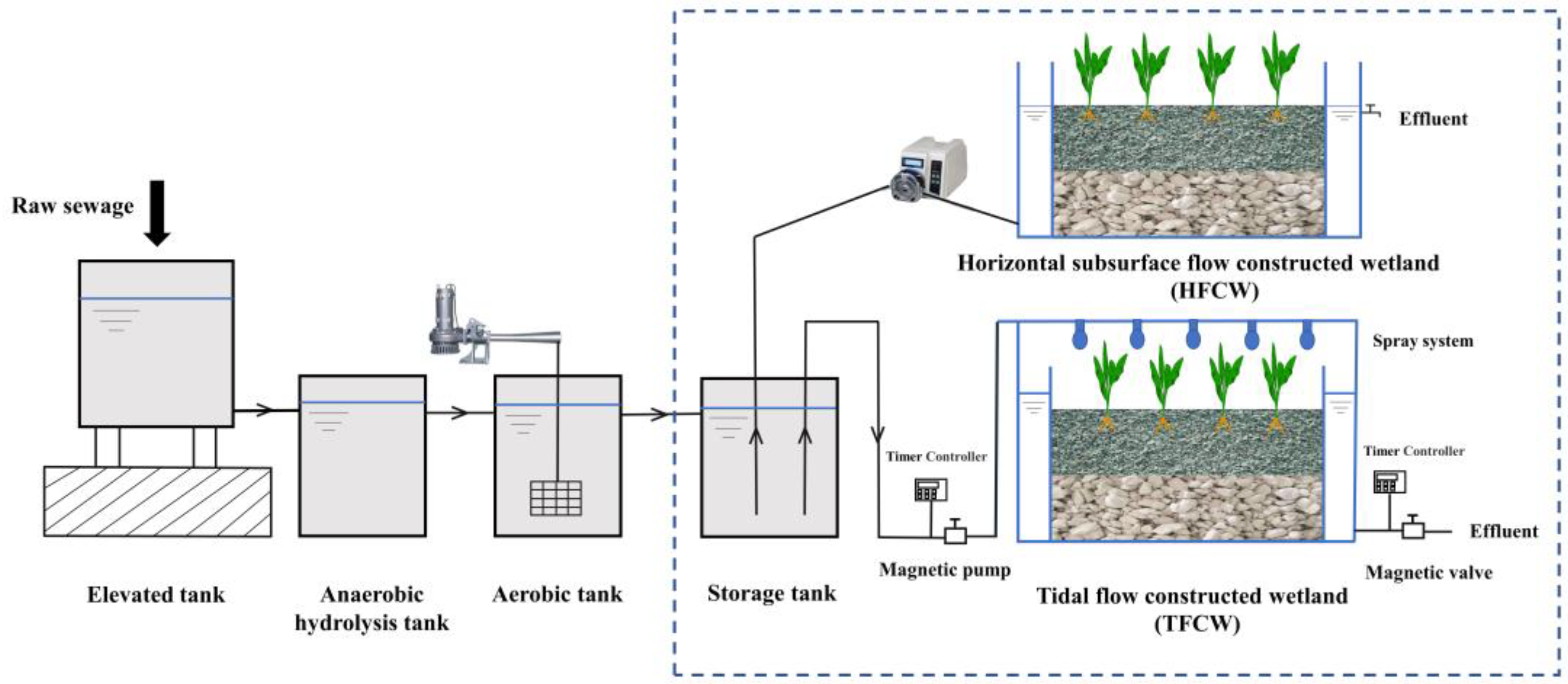
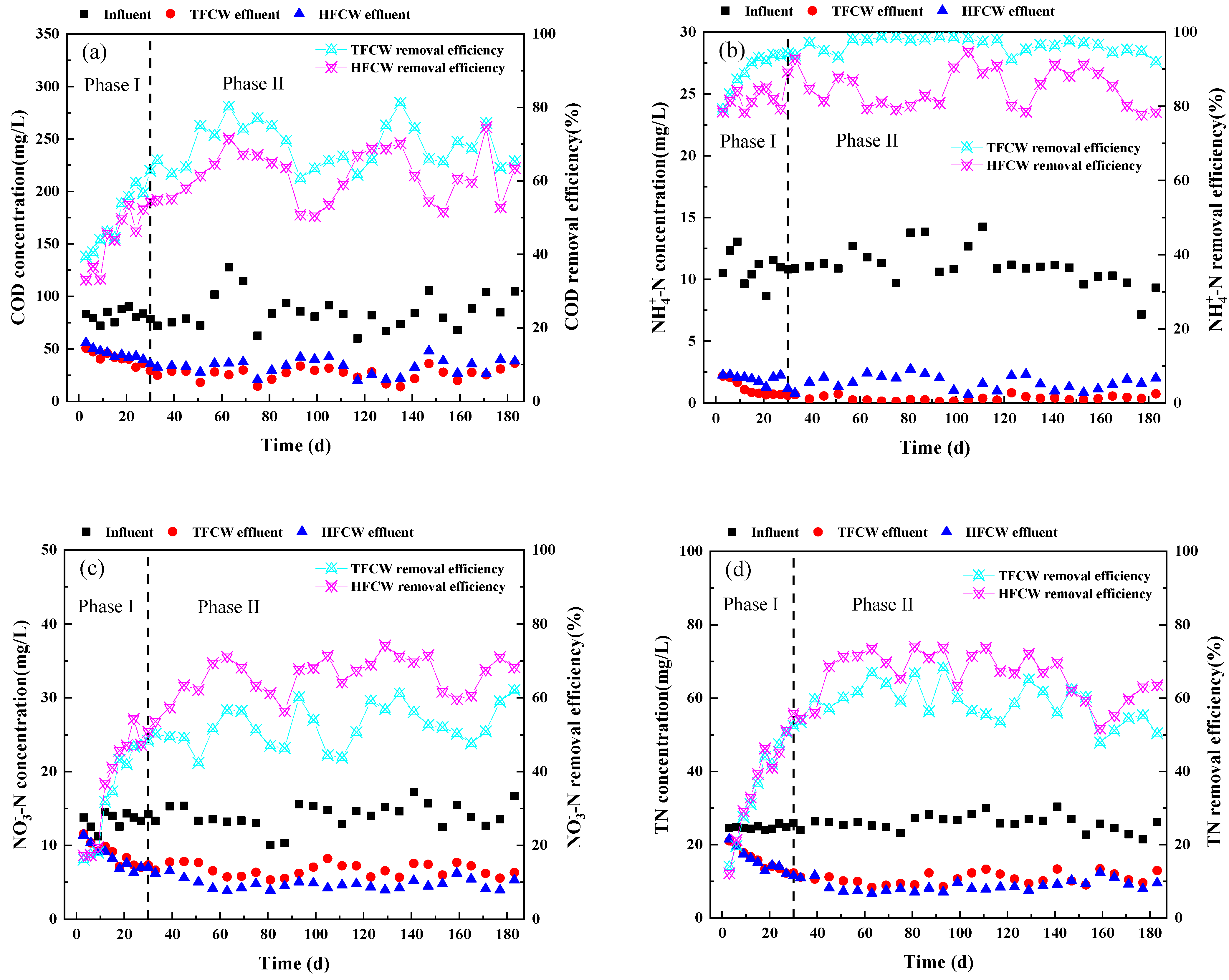
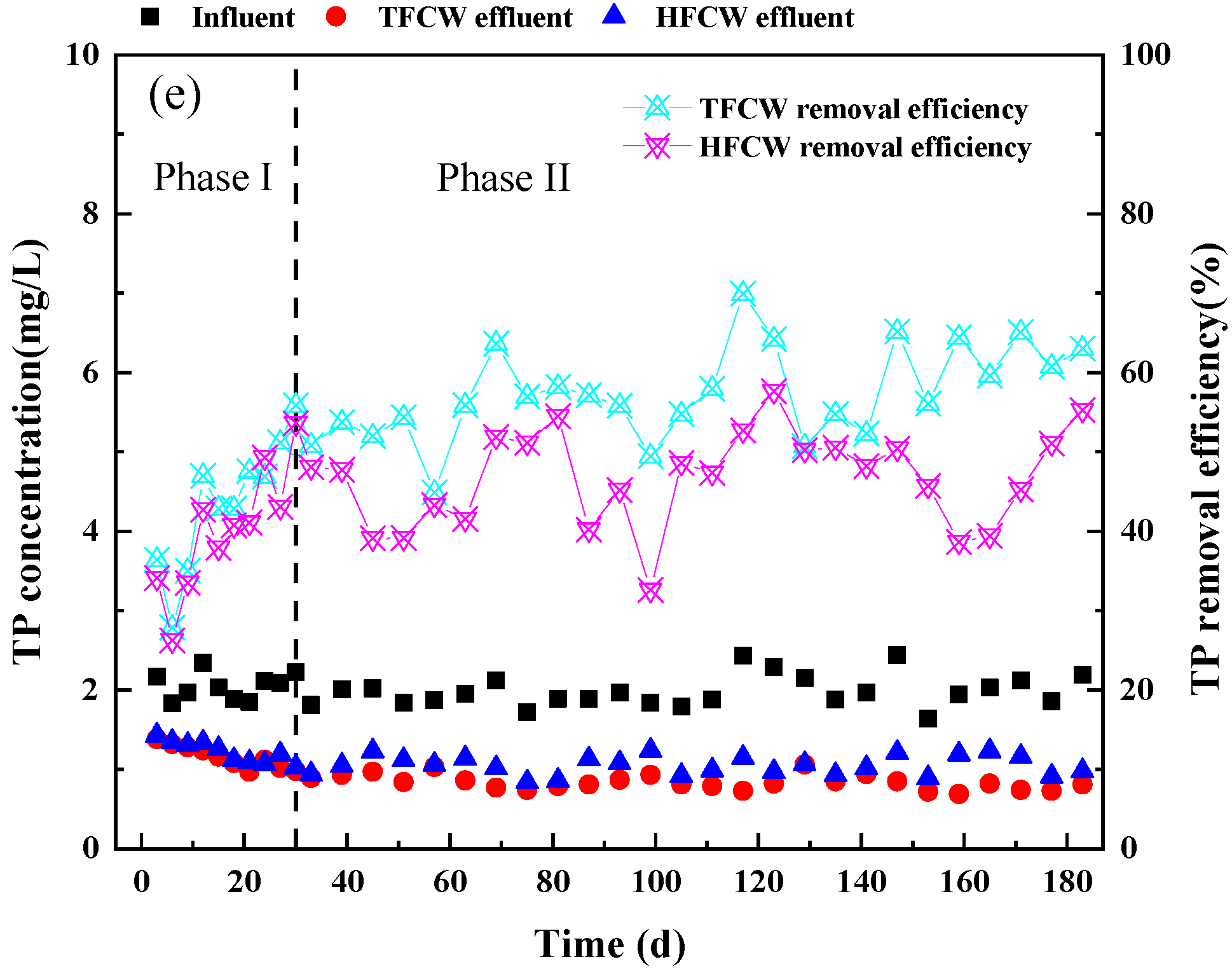
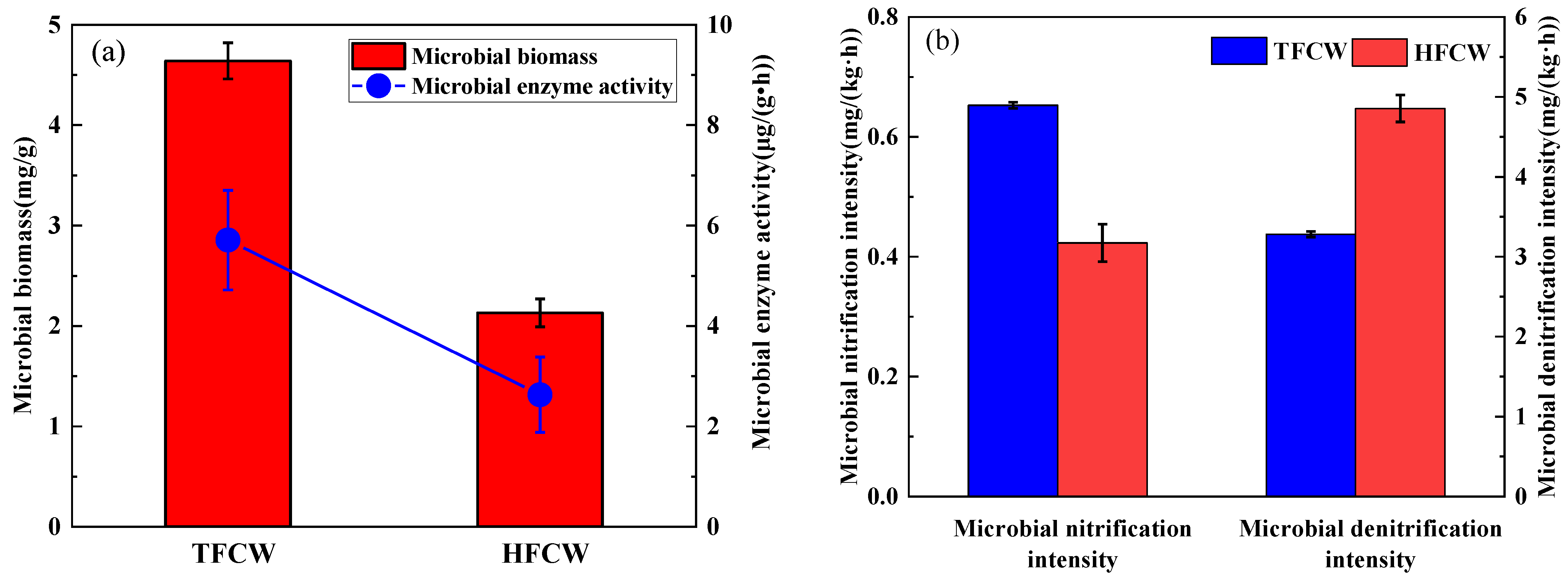
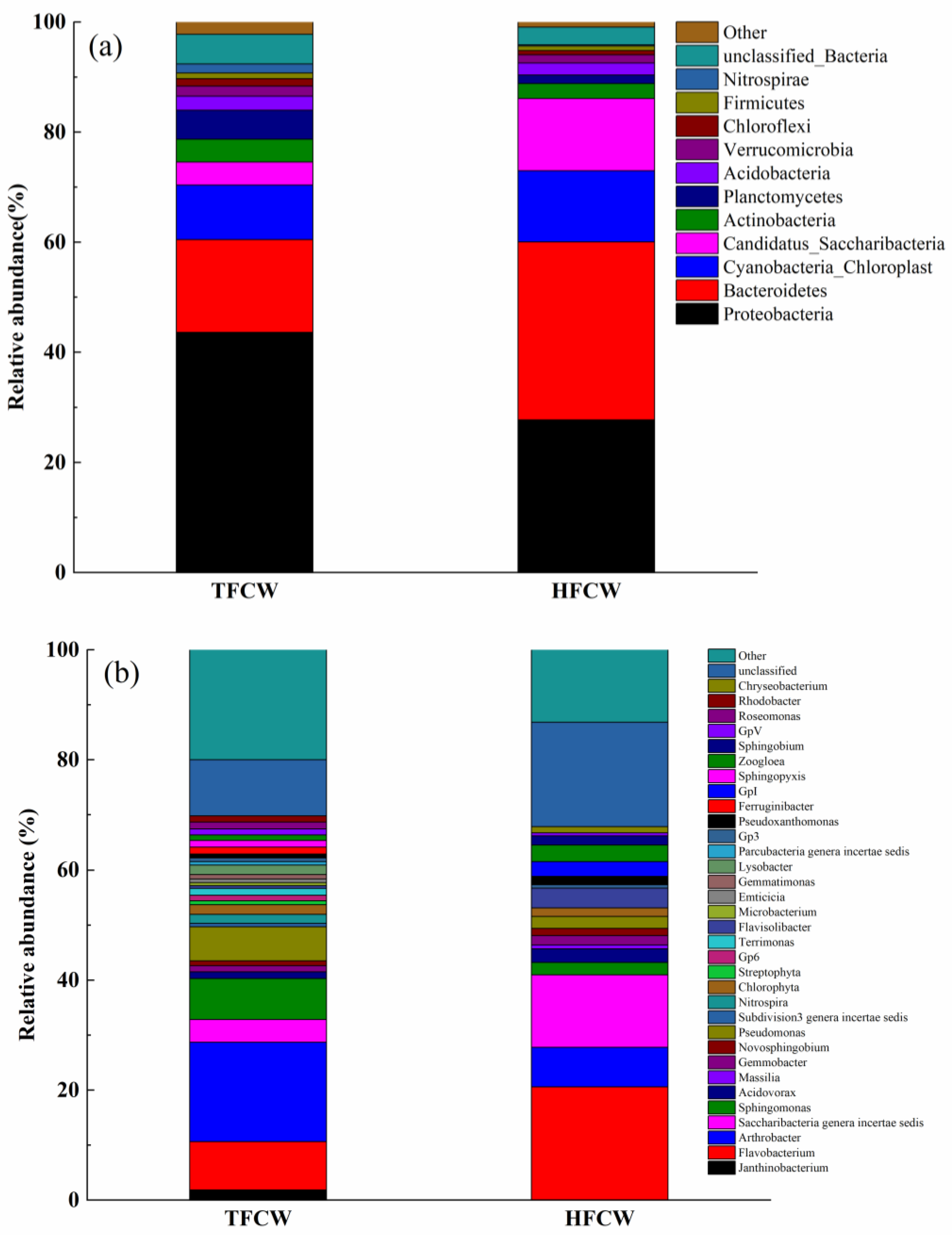
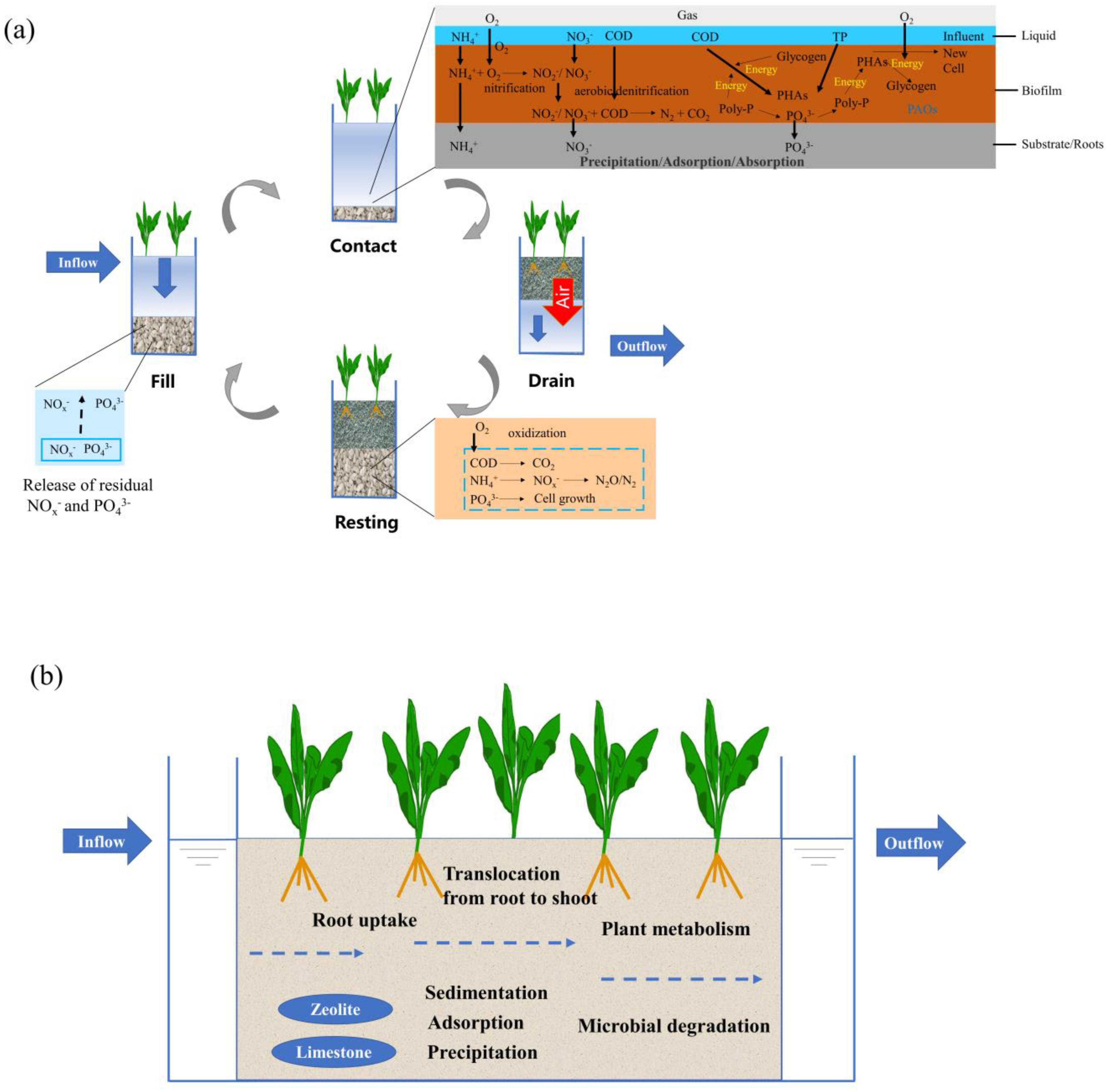
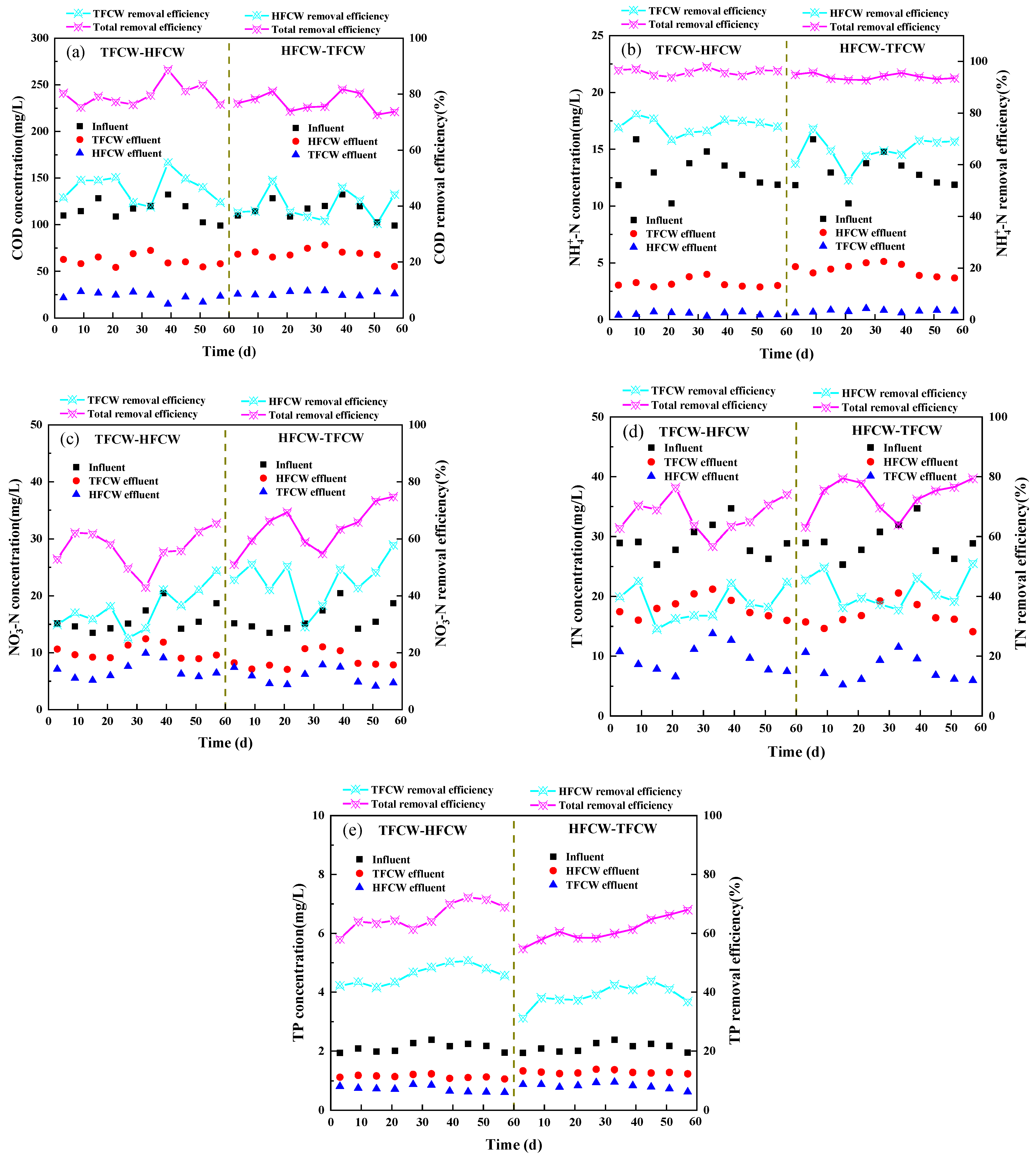
| Type | T (°C) | COD (mg/L) | NH4+-N (mg/L) | -N (mg/L) | TN (mg/L) | TP (mg/L) | DO (mg/L) |
|---|---|---|---|---|---|---|---|
| single-stage CW | 20–40 | 59.93–127.67 | 7.16–14.25 | 10.04–17.25 | 21.51–30.36 | 1.64–2.44 | 2.48–4.35 |
| two-stage CW | (−4)–15 | 98.98–132.38 | 10.23–15.88 | 13.52–20.46 | 25.32–34.69 | 1.93–2.38 | 3.32–6.56 |
| Samples | OTUs | Shannon Index | Chao | ACE Index | Coverage |
|---|---|---|---|---|---|
| TFCW | 1377 | 5.42 | 1658.04 | 1615.98 | 0.996 |
| HFCW | 1253 | 4.66 | 1497.45 | 1478.52 | 0.996 |
Disclaimer/Publisher’s Note: The statements, opinions and data contained in all publications are solely those of the individual author(s) and contributor(s) and not of MDPI and/or the editor(s). MDPI and/or the editor(s) disclaim responsibility for any injury to people or property resulting from any ideas, methods, instructions or products referred to in the content. |
© 2023 by the authors. Licensee MDPI, Basel, Switzerland. This article is an open access article distributed under the terms and conditions of the Creative Commons Attribution (CC BY) license (https://creativecommons.org/licenses/by/4.0/).
Share and Cite
Wang, S.; Teng, Y.; Cheng, F.; Lu, X. Application Potential of Constructed Wetlands on Different Operation Mode for Biologically Pre-Treatment of Rural Domestic Wastewater. Sustainability 2023, 15, 1799. https://doi.org/10.3390/su15031799
Wang S, Teng Y, Cheng F, Lu X. Application Potential of Constructed Wetlands on Different Operation Mode for Biologically Pre-Treatment of Rural Domestic Wastewater. Sustainability. 2023; 15(3):1799. https://doi.org/10.3390/su15031799
Chicago/Turabian StyleWang, Siyu, Yifei Teng, Fangkui Cheng, and Xiwu Lu. 2023. "Application Potential of Constructed Wetlands on Different Operation Mode for Biologically Pre-Treatment of Rural Domestic Wastewater" Sustainability 15, no. 3: 1799. https://doi.org/10.3390/su15031799
APA StyleWang, S., Teng, Y., Cheng, F., & Lu, X. (2023). Application Potential of Constructed Wetlands on Different Operation Mode for Biologically Pre-Treatment of Rural Domestic Wastewater. Sustainability, 15(3), 1799. https://doi.org/10.3390/su15031799





